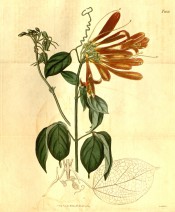Pyrostegia venusta Miers
Frost tender, vigorous climber with numerous slender stems and opposite leaves composed of lance-shaped leaflets to 8cm long. Terminal clusters of curved, tubular, waxy, golden to reddish-orange flowers are borne in profusion, mainly in winter. To 10m or more. [RHSE, Hortus].
Horticultural & Botanical History
‘As far as we can trace, the species has not been noticed in any publication. On the score of ornament there cannot be a more desirable acquisition for our collections. It grows naturally in the neighbourhood of Rio Janeiro, and the gardener who raised it from seed, thinks that it will be found to be as hardy as the common Blue Passionflower, which comes from the same country and is known to every one. It spreads itself on all sides, and continues to produce large bunches of flowers for a long time in succession from the ends of the branches.’ [BR f.249/1818].
‘Communicated by Mr. William Smith, who has the care of Lord Liverpool’s garden at Combe-Wood; he at the same time informed us, that the plant was sent from the Brazils to his Lordship by Sir John Beresford in 1815: and that it flowered for the first time in 1817.’ [BM t.2050/1819].
‘Were it possible to bring together all the most ornamental objects which have from the remotest ages engaged the talent and affections of floriculturalists, we are persuaded that there would be a new era in the art, and that the choicest collections would assume quite another aspect. As with the noble and the gifted among the human race, there are many lovely individuals which, in spite of every effort on the part of those who appreciate their worth, lie buried in the all-absorbing tomb of time, few evincing readiness to put forth a hand and rescue their merits from the abliviousness with which they are apt to be regarded. […] At the seat of H. T. Hope, Esq., Deepdene, near Dorking, our astonishment and admiration were very forcibly elicited by a plant of Bignonia venusta, which was flowering in the stove. It was trained along a simple spar of wood, near the back of the house, within a foot of the roof, and the main stems extended to the length of between thirty and forty feet. From these there were probably about three hundred lateral branches […] at the extremities of which, clusters of flowers […] displayed their truly golden glories, and created a scene beyond measure enchating.’ [MB p.123/1840]. FS f.745/1852.
History at Camden Park
Listed in the 1850 and 1857 catalogues [T.161/1850]. It was probably obtained from Loddiges’ nursery. It was included among desiderata in a letter dated 16th April 1846. [MP A2933-1, p.147].
Notes
Published Feb 25, 2010 - 02:58 PM | Last updated Jul 15, 2010 - 01:59 PM
| Family | Bignoniaceae |
|---|---|
| Category | |
| Region of origin | South America |
| Synonyms |
|
| Common Name | Golden shower |
| Name in the Camden Park Record |
Bignonia venusta |
| Confidence level | high |


